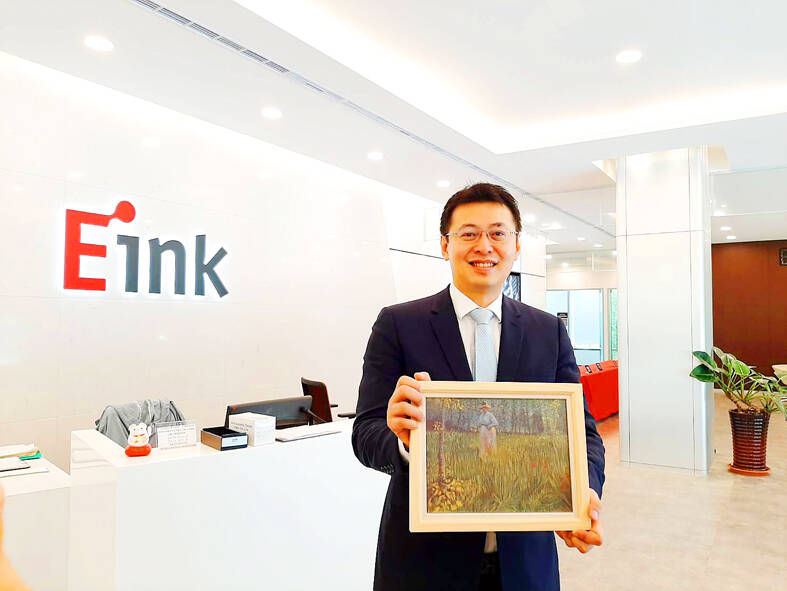E Ink Holdings Inc (元太科技), the world’s sole e-paper display supplier, yesterday said that revenue would grow by a single-digit percentage sequentially this quarter, thanks to retailers’ demand for electronic shelf labels (ESL), but concerns over a recession would affect consumer demand for e-readers and e-notes.
Next quarter would see a seasonal slowdown, with revenue contracting on a quarterly basis, but expanding annually, E Ink chairman Johnson Lee (李政昊) told investors at an online conference yesterday.
“We are conservative about overall market demand next year, but we believe there is still a chance to grow,” Lee said. “ESL would be the segment that outshines others.”

Photo: Chen Mei-ying, Taipei Times
E Ink is optimistic about US retailers’ uptake of ESLs next year, which should benefit the company and its partners in the e-paper display ecosystem, Lee said.
The US’ ESL market is 10 times larger than that of the European market, Lee added.
“Retailers are facing challenges amid a high-inflation era as they have to adjust prices within a very short period. At this point, it is not easy to find entry-level workers when the economy reopens,” Lee said. “We have received ESL orders, but the uncertainty is whether they would install ESLs ahead of schedule, or delay it.”
The company said it would keep a watchful eye on changes in the e-reader and e-note market, as demand could sag if there is a recession next year, Lee said.
On the other hand, demand could swing up following the introduction of e-readers and e-notes with color displays, he said.
E Ink said it is sticking to its projected capital expenditure of between NT$5 billion and NT$6 billion (US$160.5 million and US$192.6 million) for this year and likely next year.
Most capacity expansion plans at home, in the US and China are progressing according to the company’s schedule, Lee said.
The company more than doubled its net profit last quarter to NT$8.08 billion, from NT$4.24 billion in the third quarter last year.
E Ink plans to ramp up the production of its H4 production line in Hsinchu in the first quarter of next year.
It expects to install new equipment at the H5 production line in another Hsinchu fab next year or in 2024.
The H6 line, also in Hsinchu, is expected to commence production in 2025, it said.
E Ink said it tends to delay the construction of a new production line in Taoyuan’s Guanyin District (觀音) due to a labor shortage and high material costs.
The company’s third-quarter net profit skyrocketed to NT$4.24 billion from NT$1.23 billion a year earlier.
On a quarterly basis, net profit more than doubled from NT$2.37 billion.
Earnings per share (EPS) jumped to NT$3.72 from NT$1.08 a year earlier and NT$2.08 the previous quarter.
Third-quarter revenue soared to NT$8.1 billion from NT$4.4 billion a year earlier and NT$7.45 billion the prior quarter.
In the first three quarters, net profit surged to NT$8.08 billion from NT$3.79 billion the previous year, with EPS climbing to NT$7.08 from NT$3.33.

The US dollar was trading at NT$29.7 at 10am today on the Taipei Foreign Exchange, as the New Taiwan dollar gained NT$1.364 from the previous close last week. The NT dollar continued to rise today, after surging 3.07 percent on Friday. After opening at NT$30.91, the NT dollar gained more than NT$1 in just 15 minutes, briefly passing the NT$30 mark. Before the US Department of the Treasury's semi-annual currency report came out, expectations that the NT dollar would keep rising were already building. The NT dollar on Friday closed at NT$31.064, up by NT$0.953 — a 3.07 percent single-day gain. Today,

‘SHORT TERM’: The local currency would likely remain strong in the near term, driven by anticipated US trade pressure, capital inflows and expectations of a US Fed rate cut The US dollar is expected to fall below NT$30 in the near term, as traders anticipate increased pressure from Washington for Taiwan to allow the New Taiwan dollar to appreciate, Cathay United Bank (國泰世華銀行) chief economist Lin Chi-chao (林啟超) said. Following a sharp drop in the greenback against the NT dollar on Friday, Lin told the Central News Agency that the local currency is likely to remain strong in the short term, driven in part by market psychology surrounding anticipated US policy pressure. On Friday, the US dollar fell NT$0.953, or 3.07 percent, closing at NT$31.064 — its lowest level since Jan.

The New Taiwan dollar and Taiwanese stocks surged on signs that trade tensions between the world’s top two economies might start easing and as US tech earnings boosted the outlook of the nation’s semiconductor exports. The NT dollar strengthened as much as 3.8 percent versus the US dollar to 30.815, the biggest intraday gain since January 2011, closing at NT$31.064. The benchmark TAIEX jumped 2.73 percent to outperform the region’s equity gauges. Outlook for global trade improved after China said it is assessing possible trade talks with the US, providing a boost for the nation’s currency and shares. As the NT dollar

The Financial Supervisory Commission (FSC) yesterday met with some of the nation’s largest insurance companies as a skyrocketing New Taiwan dollar piles pressure on their hundreds of billions of dollars in US bond investments. The commission has asked some life insurance firms, among the biggest Asian holders of US debt, to discuss how the rapidly strengthening NT dollar has impacted their operations, people familiar with the matter said. The meeting took place as the NT dollar jumped as much as 5 percent yesterday, its biggest intraday gain in more than three decades. The local currency surged as exporters rushed to